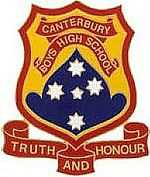Canterbury Boys' High School
| Canterbury Boys' High School | |
|---|---|
|
Truth and Honour | |
| Location | |
|
Canterbury, New South Wales Australia | |
| Coordinates | 33°54′15″S 151°7′25″E / 33.90417°S 151.12361°ECoordinates: 33°54′15″S 151°7′25″E / 33.90417°S 151.12361°E |
| Information | |
| Type | Public, Single-sex, Secondary, Day school |
| Established | 1918[1] |
| Principal | Mr. D Hill |
| Enrolment | ~466 (7–12)[2] |
| Campus | Suburban |
| Colour(s) |
Navy Blue, Gold and Red |
| Website | |
Canterbury Boys' High School (CBHS) is a public secondary day school for boys located in Canterbury, a south-western suburb of Sydney, New South Wales, Australia. It is located near the Canterbury Park Racecourse and next to Canterbury Girls' High School.
Established in January 1919 as the Canterbury Intermediate High School,[1] Canterbury Boys' High School is part of the St. George Region of high schools, and currently enrols around 470 students from Years 7 to 12.[2] Almost 90 per cent of the students at Canterbury Boys come from a non-English-speaking background.[3]
Canterbury Boys' High School is a school of the New South Wales Department of Education and Training (DET), and prepares students for the School Certificate (Year 10), and the Higher School Certificate (Year 12).
History
Canterbury Boys' High School traces its origins back to 1917, when a deputation from the local Primary School's Parent and Citizens Association asked the Minister for Education to open a high school in the district. There was a concern that the demand for places in local High Schools would exceed available places, and as a result of this request, the Department decided to establish the school at Canterbury.[4]
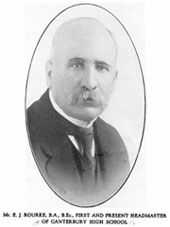
The school was opened in January 1918, in what is now the Primary School buildings, and began operating with two classes and 72 students, with Mr. Ernest John Rourke B.A. as Headmaster. The school was initially an intermediate high school (1st to 3rd year), and was therefore named Canterbury Intermediate High School. At its foundation, the search had already begun for a more appropriate site for the new school.[4]
In 1919, the land on which most of the original part of the school now stands was resumed, and plans for the new school were prepared. A section of the resumed land is historic, forming part of a 100-acre (0.40 km2) grant made by the Rev. Richard Johnson on 20 May 1793. This farm was called "Canterbury Vale", and it was from this that the suburb of Canterbury and the school is named. Plans for the new building were completed in late December 1923, and a tender for £22,000 (A$44,000) was accepted in May 1924. The building was completed and occupied in July 1925 and officially opened on 1 August of that year.[4]
The building was soon overcrowded due to the rapid growth of population in the area served by the school, and so plans for extensions were started. Further land acquisitions occurred in 1929 and 1931, and in 1933 the extensions to the northern and southern wings of the original building were completed.[4]
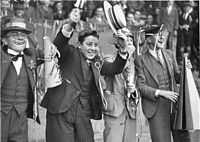
The school became a full High School in 1925, and was subsequently renamed Canterbury Boys' High School. For some years, difficulty was experienced in encouraging boys to complete 4th Year, and to sit for the Leaving Certificate Examination the following year. This was due in part to the difficult economic conditions of the time, and in other cases, boys preferred to enrol in one of the more established high schools such as Sydney Boys' High School and the Sydney Technical High School. In order to increase enrolments in 4th year, Mr. Rourke pressured the Department, and boundary lines were established so that boys living within the area were compelled to enrol at Canterbury. The school was to later become a selective high school from which time many student enrolments were from out of area.[4]
Further land on the northern side of the school was resumed in 1945, and later the gymnasium was erected on part of this land, and completed in 1954. Increasing enrolments and a lack of specialist rooms led to a major extension of the school buildings again being undertaken. The new structure, opened in 1969, contained six science laboratories, two music rooms, three art rooms, two technical drawing rooms, two woodwork rooms, a metalwork room, a new library and several classrooms, new toilets and a new canteen. This extension was connected to the old building via overhead walkways, and due to it being constructed around a central courtyard, quickly gained the name of the 'doughnut' block.[4]
The appearance of the school changed little over the next two decades, however that was changed in 1988. Canterbury had been campaigning for a multipurpose hall for many years, and so there was much disappointment when a major refurbishing program for the original building and the provision of another classroom block did not include a school hall. There was however a transformation of the original building to that of which is present today. The main changes were lowering of the ceilings, replacement of the assembly hall, the conversion of some rooms on the top floor to a multi-purpose library, transferring the administration office to the front entrance, providing study rooms and two new staff rooms, and reducing the size of the original staff room. A ground level and first floor walkway was also constructed along the eastern side of the building.[4]
The school remained selective until 1976 when it became a comprehensive high school as part of the school restructuring at the time. Today many of the school’s programs have received acclaim in the printed media, on television and in Parliament. The school also received the Director General School Achievement to: "recognise the exceptional quality and outstanding achievements of this school in its Student Welfare Program and Harmonious Race Relations."[4]
Principals
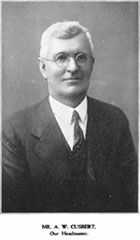
| Period | Details[4] |
|---|---|
| 1918 – 1932 | E.J. Rourke |
| 1933 – 1946 | A.W. Cusbert |
| 1947 – 1949 | W.D. Noakes |
| 1950 – 1954 | F.C. Wotton |
| 1955 – 1960 | E.R.S. Watson |
| 1961 – 1974 | R.M. Cooper |
| 1975 – 1979 | R.J. Oliver |
| 1980 – 1984 | J. Coutman |
| 1984 – 1986 | D. O'Carrigan |
| 1987 – 1997 | B.A. Mackenzie |
| 1998 – 2006 | A. Martin |
| 2006 – 2012 | L. Mitton |
| 2012 – present | D. Hill |
Facilities
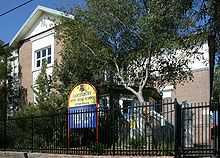

the main buildings
The facilities of Canterbury Boys' High School include a library for texts and references and four main computer labs with smaller computer rooms scattered around the school buildings for the many courses which require computer access. It also has facilities for technology and fine arts programs, science labs, a gym, two outdoor basketball courts, and an oval for its physical education and sports programs.
Canterbury Boys' High School a school of the New South Wales Department of Education and Training (DET),[2] and is registered and accredited with the New South Wales Board of Studies, therefore following the mandated curriculum for all years. It is a comprehensive high school,[5] the Higher School Certificate (Year 12).
Co-curriculum
CBHS generally performs well in the various sports competitions in its region, and it has a successful chess team. The school holds an annual "Cantervale" musical concert to showcase the talents of students and teachers, as well as featuring many cuisines and snacks from different cultures, provided by teachers, students and parents.
Media
In 2004, the school featured in a four-part documentary, televised on the ABC, titled Our Boys. The program, directed by Kerry Brewster, documented the 2002 school year at Canterbury Boys' High School.[3][5]
The school is also the subject of Fred Brown's Schooldays, a book written by former student, Fred Brown. The book gives an account of life and conditions at the school during the Second world War.[4][6]
On 14 December 2010, Oprah Winfrey announced a $1,000,000 donation to the school. The donation came after substitute teacher, Polly Dunning, made a written appeal to Oprah Winfrey in an on-line questionnaire associated with Oprah's tour of Australia. The donation is being provided for the purchase of a laptop for each student and computers for the library and music department.
Oprah Winfrey donation
During the first of two live shows in the Sydney Opera House on 14 December 2010, Oprah Winfrey donated $1 million to the school to overhaul the school's library and music rooms as well as providing laptops for every student at the school. The show included a live cross to the students who were in attendance.[7]
Old Cantabrians Union
Alumni of Canterbury Boys' High School are known as Old Cantabrians, and may join the schools alumni association, the Old Cantabrians' Union. The union was inaugurated in 1928, and today former students often visit the school, and are represented at formal functions such as the Year 12 Farewell, Presentation Night and the Prefects Induction evening.
Notable alumni
Some notable Old Cantabrians' include:
- This list is incomplete; you can help by expanding it.
- Academic
- Samuel Ball, foundational education evaluator of Sesame Street, Pro Vice Chancellor Sydney University, CEO Board of Studies Victoria
- Samuel Warren Carey – geologist[8]
- John Coutman – former CBHS Principal (1980–1984)[4]
- Frank Jones – sociologist; professor at the Australian National University, Research School of Social Sciences (1973–2001)
- John Lovering – geologist; professor at the University of Melbourne[9]
- William McBride (doctor) - Gynecologist and obstetrician - discover
- Laurie Mather (LC 1957), professor of Anaesthesia, University of Sydney
- Dr Jeffrey Miller - Ed D, AM, founding principal (Vice Chancellor) of Cumberland College of Health Sciences (1972-1990), Australian Member (AM) for services to education (1986), Honorary Professor Chinese Academy of Medical Sciences and Peking Union Medical College (1988).
- Ron Ridley (LC 1957), personal chair in History, University of Melbourne
- Ian Sharpe (LC 1957), prof. of Finance, University of NSW
- Douglas Trathen – former headmaster of Newington College (1963–1970)
- David Husoy - CEO of ThyssenKrupp (2003–present)
- Colin Bale; historian &Anglican clergyman, Vice-Principal of Moore Theological College, Chairman of St Andrew's Cathedral School Council
- Medicine
- Dr Don Sheldon: Distinguished surgeon. He led a surgical unit of doctors from RPA to provide medical aid to Vietnam in 1967
- Emeritus Professor Kim Oates: Distinguished paediatrician and former CEO Westmead Children's Hospital
- Dr William McBride (doctor); Gynecologist and obstetrician who revealed to the world the dangers of Thalidomide
- Entertainment, media and the arts
- Fred Brown – author[6]
- Bill Collins – film historian and TV presenter[4]
- Nicholas Papademetriou Actor
- Grahame Bond – comedian, actor and creator of The Aunty Jack Show[4]
- Murray Sayle – journalist, editor and commentator[10]
- Keith Windschuttle – historian, author and publisher, his most notable and controversial work being The Fabrication of Aboriginal History[11]
- Trevor Sinlair – long time Sydney radio announcer and journalist
- Eddy Meyer – News reporter for the 10 Network
- politics, public service and the law
- Jim Cameron (politician); former MLA for Northcott[12]
- Hon Ron Dyer; former Member of the Legislative Council
- Ken Gabb – former MLA for Earlwood[4]
- J. Goodsell – dormer chairman of the Public Service Board[4]
- John Howard – Prime Minister of Australia (1996–2007); only PM in modern Liberal Party history to have been educated at a public school (Class of 1956)[3]
- Keith Pearson – former leader of the National Archives of Australia[13]
- Hon John Ryan (New South Wales politician); former Member of the Legislative Council
- Eric John Shields QC – barrister; former Senior Public Defender (NSW) (also attended Orange High School)[14]
- Frank Sleeman – former Lord Mayor of Brisbane[15]
- D. Swan - former Director General of Education[4]
- Religion
- Raymond Nobbs – Dean and CEO of the Sydney College of Divinity[16]
- Robert Porter OBE – former Bishop of the Anglican Diocese of The Murray, South Australia[4]
- Bruce Wilson, former Anglican Bishop of Bathurst
- Peter Watson – archbishop of the Anglican Diocese of Melbourne from 2000 to 2005
- Sport
- Alofa Alofa – Waratahs Rugby Union Prop
- Geoff Bugden – former Newtown Jets and Parramatta Eels prop and 1980 Rothmans Medal winner
- Peter Spathis – Australian futsal and Australian fifa futsal worldcup team goal keeper from 2004 to present
- David Frith – cricket author and historian, editor of Wisden Cricket Monthly 1979–1996
- Pierre Hola – Tongan World Cup 5/8 & Pacific Islander's rugby 5/8. World record holder for most successful conversions in a row in a Rugby test match 17/17 and one point away from a world record for most points in a test match 44 points (record 45)
- Ted Glossop – former Canterbury Rugby League football coach[4]
- Arthur Morris – former Captain Australian Cricket[4]
- Anthony Mundine – boxer and former Rugby League player (also attended Cleveland Street High School and Kingsgrove High School)[17]
- George Peponis – former Australian Rugby League Test captain and present CEO of the Canterbury Bulldogs[4]
- Leo Epifania former Western Suburbs 1st grade footballer and current coach of Wests VB Premier league side.
- John Kambas former Cronulla Rugby League footballer .
- Jim Emirian former Newtown Rugby League footballer.
See also
- List of Government schools in New South Wales
References
- ↑ 1.0 1.1 "History of Canterbury (Suburb)". Suburbs List. City of Canterbury. 2006-11-24. Retrieved 2008-02-20.
- ↑ 2.0 2.1 2.2 "Canterbury Boys High School". School Locator. New South Wales Public Schools. Retrieved 2008-02-20.
- ↑ 3.0 3.1 3.2 Burke, Kelly (2004-02-10). "One of the old school". TV & Radio (The Age). Retrieved 2008-02-20.
- ↑ 4.0 4.1 4.2 4.3 4.4 4.5 4.6 4.7 4.8 4.9 4.10 4.11 4.12 4.13 4.14 4.15 4.16 4.17 4.18 4.19 "School History". History. Canterbury Boys' High School. Retrieved 2008-02-20.
- ↑ 5.0 5.1 "School Introduction". About. Canterbury Boys' High School. Retrieved 2008-02-20.
- ↑ 6.0 6.1 "What's New in Local & Family History -- Spring 2006". Local History and Heritage. City of Canterbury. 2006-11-24. Retrieved 2008-02-29.
- ↑ "Oprah gives back to Sydney". ABC News. 14 December 2010.
- ↑ "Teachers notes – Professor Sam Carey (1911–2002)". List of Interviews. Australian Academy of Science. Archived from the original on 2007-09-03. Retrieved 2008-02-20.
- ↑ "Lovering, John Francis (1930 - )". Faculty of Science at the University of Melbourne. The University of Melbourne. 2001. Retrieved 2008-02-20.
- ↑ Tudor, Geoffrey (2008-01-16). "Murray Sayle Finally Graduates From Sydney University". FCCJ. FCCJ: The Foreign Correspondents' Club. Retrieved 2008-02-20.
- ↑ "Author". The Sydney Line. Keith Windschuttle. Retrieved 2008-02-20.
- ↑ Nile, Fred (2007). [Jim Cameron (politician)http://www.cdp.org.au/fed/cvjac.asp "James (Jim) Cameron"]. 2007 Federal Election. Christian Democratic Party. Retrieved 2008-02-20.
- ↑ "Leaders of the National Archives". Leaders. National Archives of Australia. Retrieved 2008-02-20.
- ↑ Suzannah Pearce, ed. (2006-11-17). "Shields (John) Eric John". Who's Who in Australia Live!. North Melbourne, Vic: Crown Content Pty Ltd. Check date values in:
|year= / |date= mismatch(help); - ↑ "Frank Sleeman". Sleeman Sports Complex. Queensland Government. Retrieved 2008-02-20.
- ↑ "Raymond Nobbs". Program Leaders. Odyssey Travel. Retrieved 2008-02-20.
- ↑ "Anthony Mundine". Aboriginal Biographies. The Aboriginal Experience. Retrieved 2008-02-20.
Further reading
- Brown, F. 2004. Fred Brown's Schooldays. Ginninderra Press, Charnwood, A.C.T. ISBN 1-74027-262-5.
External links
| ||||||||||||||||||||||||||||||||||
